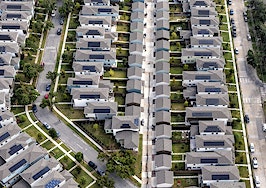New markets require new approaches and tactics. Experts and industry leaders take the stage at Inman Connect New York in January to help navigate the market shift — and prepare for the next one. Meet the moment and join us. Register here.
With mortgage rates expected to continue to retreat from 2022 highs, economists at Fannie Mae think home sales won’t fall quite as hard next year as they’d previously forecast — even with the nation expected to enter a “mild” recession during the first quarter of 2023.

Doug Duncan
“The economy caught its breath in the second half of 2022, but that doesn’t change our expectation that it will run out of air in early 2023 via a mild recession,” said Fannie Mae Chief Economist Doug Duncan in a statement.
Last month, forecasters at the mortgage giant were predicting mortgage rates would peak at 7 percent during the first three months of 2023 before beginning a steady two-year decline but not falling below 6 percent until late 2024.
Mortgage rates expected to fall

Source: Fannie Mae December 2022 housing forecast, MBA housing forecast.
In their December housing forecast, released Monday, forecasters at the mortgage giant said they think rates on 30-year fixed-rate loans peaked at 6.6 percent during the fourth quarter of 2022 and could dip below 6 percent by the first quarter of next year. In a Dec. 19 forecast, economists at the Mortgage Bankers Association projected rates will fall below 6 percent by the second quarter of 2023 and back into the 4 percent range in 2024.
What’s changed?
On Dec. 14, Federal Reserve policymakers made it clear that they’re ready to dial back the pace at which they’ve been raising the short-term federal funds rate.
That has not only had a stabilizing effect on long-term rates like Treasury yields and mortgages, but there’s room for the abnormally wide “spread” between 10-year Treasurys and mortgages to narrow, which would make home loans more affordable.
At times this year, the primary mortgage spread — the difference between 10-year Treasury yields and rates for 30-year fixed-rate conforming mortgages — has exceeded 300 basis points (3 percentage points). Although the spread has narrowed some in recent weeks, Fannie Mae economists see “significant room” for mortgage rates to come down some more — even if Treasury yields don’t.
“Looking further ahead, with the spread between the 10-year Treasury and 30-year mortgage rates remaining elevated (281 basis points as of this writing, compared to a typical range near 172 from 2015 to 2019), we believe there to be significant room for mortgage rates to eventually drift lower over the next year once the Treasury rate stabilizes,” Fannie Mae economists said in commentary accompanying their latest forecast. “As such, we expect this moderating in the mortgage rate to help support a rebound in home sales after the next business cycle returns to expansion.”
Home sales forecast to bounce back in 2024

Source: Fannie Mae December 2022 housing forecast.
“With long-run interest rates pulling back significantly over the past month, and a consequently lower mortgage rate forecast, our latest outlook included a modest increase to our home sales forecast,” Fannie Mae forecasters said. “We now expect total home sales in 2022 to be 5.72 million units, up from 5.67 million in our prior forecast.”
Economists at the mortgage giant now expect 4.57 million home sales next year, up from 4.42 million sales forecast in November. While Fannie Mae forecasters are less pessimistic than they were in November, that would still represent a 21 percent drop in sales of existing homes to 4.004 million next year. New home sales are expected to fall less severely, shrinking by 13.1 percent next year to 565,000 units.
“We expect housing to continue to slow, even though mortgage rates have come down recently,” Duncan said. “Home purchases remain unaffordable for many due to the rapid rise in rates over the last year and the fact that house prices, though certainly slowing and in some places declining, remain elevated compared to pre-pandemic levels.”
Recent declines in mortgage rates have coincided with “a sharp bump up in purchase mortgage applications, suggesting to us that some potential homebuyers sitting on the sidelines acted once rates began to decline,” Fannie Mae economists said.
But many would-be homebuyers remain priced out of the market, and many would-be sellers have mortgages “with rates well below current market conditions, a strong disincentive to move,” Fannie Mae forecasters said. “We expect this ‘lock-in’ effect to limit sales for the foreseeable future, and when combined with an expected economic slowdown, we are forecasting continued declines in existing sales next year.”
With many cyclical indicators continuing to point toward economic contraction, Fannie Mae’s Economic and Strategic Research Group is forecasting negative 0.5 percent GDP growth next year, with the economy not expanding again until 2024 at a 2.2 percent annual growth rate.
“With a recession predicted beginning in the first quarter of 2023, the ESR Group notes as plausible a scenario in which the Federal Reserve begins once again cutting the federal funds rate in mid-2023,” Fannie Mae economists said.
Get Inman’s Extra Credit Newsletter delivered right to your inbox. A weekly roundup of all the biggest news in the world of mortgages and closings delivered every Wednesday. Click here to subscribe.













